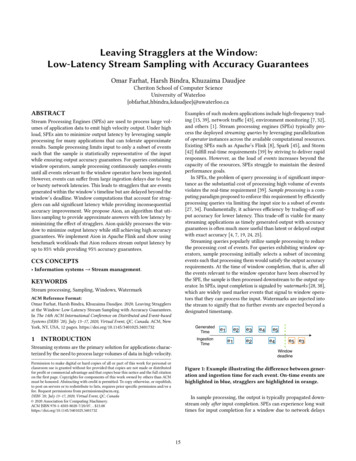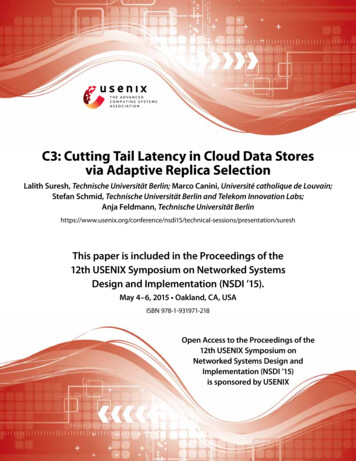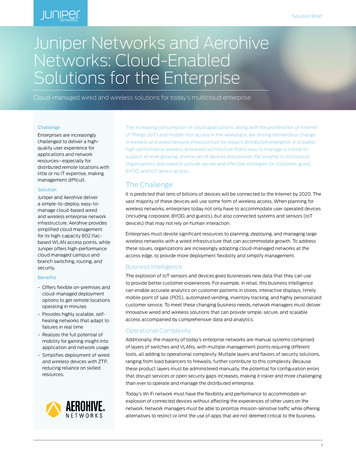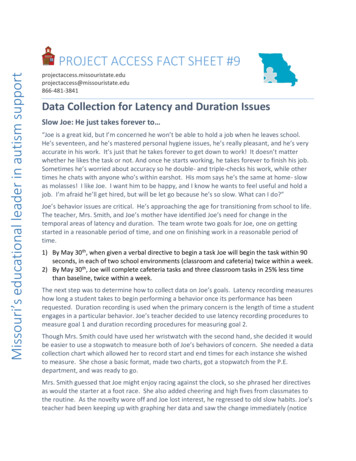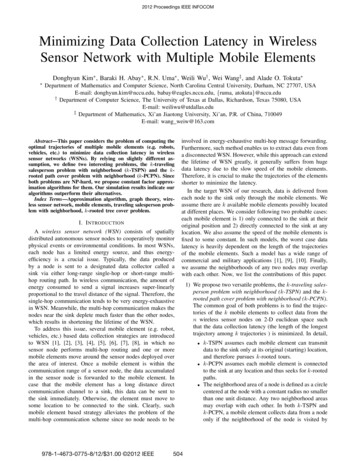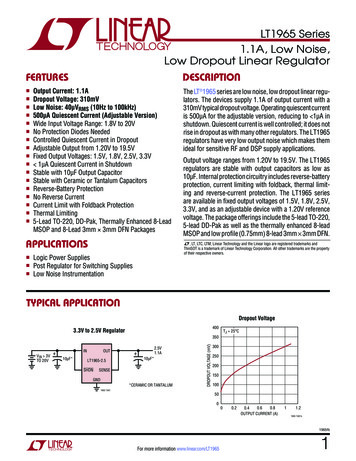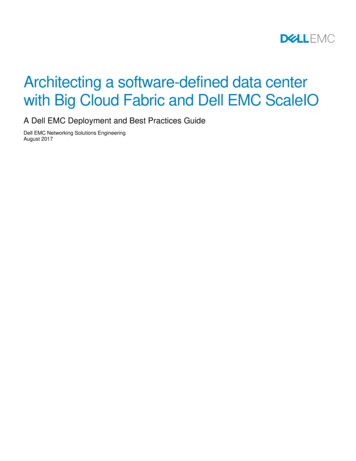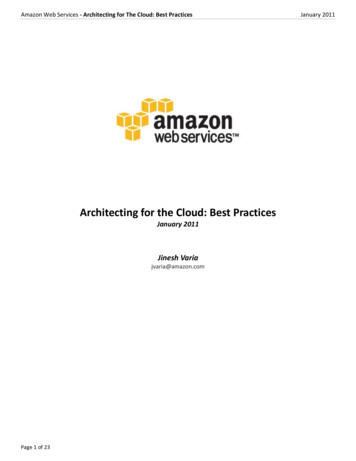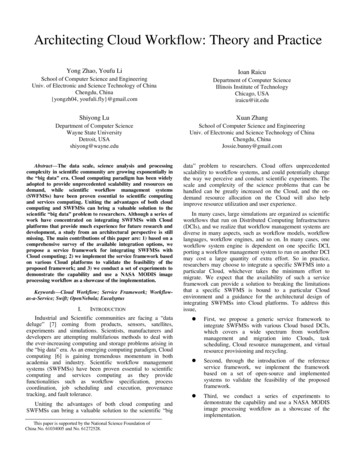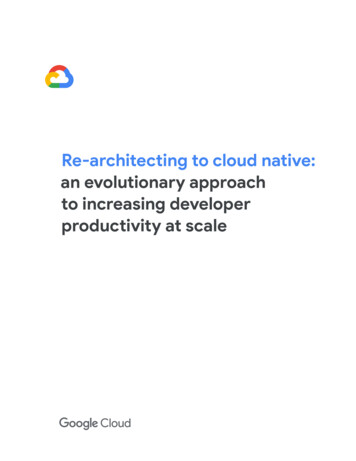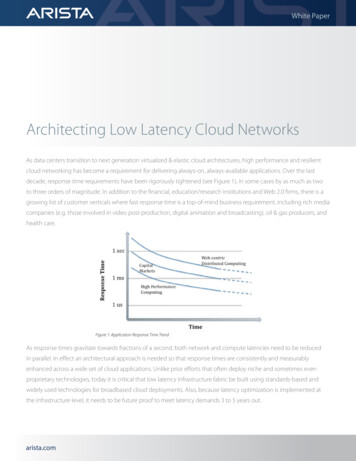
Transcription
White PaperArchitecting Low Latency Cloud NetworksAs data centers transition to next generation virtualized & elastic cloud architectures, high performance and resilientcloud networking has become a requirement for delivering always-on, always-available applications. Over the lastdecade, response time requirements have been rigorously tightened (see Figure 1), in some cases by as much as twoto three orders of magnitude. In addition to the financial, education/research institutions and Web 2.0 firms, there is agrowing list of customer verticals where fast response time is a top-of-mind business requirement, including rich mediacompanies (e.g. those involved in video post-production, digital animation and broadcasting), oil & gas producers, andhealth care.Figure 1: Application Response Time TrendAs response times gravitate towards fractions of a second, both network and compute latencies need to be reducedin parallel. In effect an architectural approach is needed so that response times are consistently and measurablyenhanced across a wide set of cloud applications. Unlike prior efforts that often deploy niche and sometimes evenproprietary technologies, today it is critical that low latency infrastructure fabric be built using standards-based andwidely used technologies for broadbased cloud deployments. Also, because latency optimization is implemented atthe infrastructure level, it needs to be future proof to meet latency demands 3 to 5 years out.arista.com
White PaperArchitecting Low-Latency Cloud NetworksA key attribute of latency-sensitive workloads is that they are built using distributed compute architecture. Each workloadtransaction spawns a large number of interactions between compute nodes, in some cases across thousands of machines and datastores, as depicted in Figure 2. For example: In algorithmic trading, machines receive market data feeds from other machines, calculate trading decisions and place tradeswith another set of machines. In HPC, thousands of commodity servers are clustered to behave as a “super computer”, connected to a clustered file system(e.g. Lustre) to crunch complex mathematical formulae and simulations. In web based cloud applications, workloads operate on thousands of dynamically clustered servers and implement multistage processing mechanisms to sift through petabytes of data. Example applications include those implemented by Web2.0 and Internet Search companies, as well as emerging open-source initiatives such as Hadoop which provides scalable andreliable framework for distributed computing (MapReduce), distributed file system and distributed database.Figure 2: Network based machine-to-machine interactions of a single workload: A transactionTo boost system-wide response time, both compute and network latencies must be minimized. Typically, commodity servers areused for computing where degrees of freedom for latency optimization are limited. One essentially selects a server with denser andfaster multi-core CPUs, larger and faster memories/caches, and speedier peripheral interconnects. The other side of latency coin isthe cloud network where fabric-wide optimization is called for to minimize transport latencies. In particular, network latencies needto be optimized across four key axes: Reduce latency of each network node Reduce number of network nodes needed to traverse from one stage to another Eliminate network congestion Reduce transport protocol latencyThe Arista AdvantageArista Networks has adopted an architectural approach to building low latency cloud networking. Its wire-rate, non-blockingand ultra low latency 1Gb/10GbE switches, along with extensible operating system (EOS), enable resilient cloud networks fortransporting data, multi-media, storage and compute traffic. Architecting cloud networks based on Arista’s 7xxx series switch fabrichas the following advantages: Reduce network latencies across all four axes (see details below); Future-proof the network infrastructure for latency demands of today and tomorrow; Implement standard Ethernet, which is widely deployed and operationally well understood.arista.com
White PaperNetwork Node LatencyFor ultra low latency workloads, such as those in financials and HPC, shaving off every microsecond is important. Deploying theoptimal 1/10Gb Ethernet switch can improve latency by 10 microseconds for 1500B Ethernet frames (even more if the 9KB jumboframes are used). Also, the cut-through switch architecture can reduce additional tens of microseconds of over older store-andforward designs. Arista provides dense 10Gb switches with cut-through architecture that yields switching latencies in the range of0.6 - 1.2 microsecond (see Figure 3).Figure 3: Latency benefits of Arista’s cut‐through switches over traditional store‐and‐forward switches(a) Legacy Store-and-Forward Design(b) Arista Cut-Through DesignIntra-Rack Latency: 8µsIntra-Rack Latency: 0.6µsInter-Rack Latency: 36µsInter-Rack Latency: 2.4µsNumber of Network HopsTypical data center architecture consists of a three-tier architecture, with server access, distribution and core switch layers. Oftenpackets need to traverse all the way to the core layer when communicating across server racks. In Arista’s two-tier topology with leafand spine switches (see Figure 4), latency is significantly reduced as packets traverse fewer hops.Figure 4: Arista’s 2‐tier (leaf and spine) topology reduces latency over traditional 3‐tier (access,distribution, core) topologyarista.com
White PaperNetwork CongestionIn most applications, IP/Ethernet packets are transported using the TCP protocol. To guarantee reliability and maintain throughput,TCP state machine uses windowing to adjust to dynamic network congestion. During congestion periods, TCP uses smaller windows,thus decreasing throughput and increasing overall transmission latency. Traditional data center architecture is oversubscribed, thusleading to congestions & dropped packets and hence large TCP latencies. Arista’s 7100 switches are wire-rate switches (line rate forevery 10Gb Ethernet port), thus enabling non-oversubscribed cloud network architectures with 1:1 bisectional bandwidth (as shownin Figure 4). Large, congestion-free, fabric can be architected that allows TCP to operate using large window sizes and hence at highthroughput and low latency. Hundreds or thousands of machine-to- machine TCP interactions of application workloads, be theyweb, file/storage, multi-media or database, benefits immensely in terms of TCP throughput and latency.Transport Protocol LatencyCertain low latency environments (e.g. HPC, applications leveraging Lustre file system algorithmic trading), it is desired to bypassTCP altogether and instead leverage direct machine-to-machine communication using message-passing (MPI) or remote directmemory access (RDMA). Infiniband and other proprietary interconnects have been used because of their ultra low latency, highthroughput and lossless characteristics. Customers have longed for standards- based Ethernet to provide such capabilities as wellas price-performance advantage so that they can benefit from the cost-efficiencies of managing a single Ethernet fabric acrossthe public or private cloud. Arista’s 7100 series of 10Gb Ethernet switches, with line rate and cut-through low latency performance,enables a single low latency cloud network. Arista’s architecture also supports current and emerging Ethernet standards in IEEE andIETF on Layer-2/3 multi-pathing and congestion control to span large congestion free domains. Large Layer-2 domains, along withArista’s low latency, wire- rate and congestion-free cloud network, enable rapid migration of application workloads anywhere in thecloud.Low-Latency Application Example: Capital MarketsAlgorithmic trading and market data feeds are the most celebrated use cases of ultra low latency designs where it is said that“1-millisecond advantage in trading applications can be worth 100 million a year to a major brokerage firm”1 . Shaving offmilliseconds is so critical that brokerage firms co-locate their trading systems right on the exchange floor for direct access to marketdata feeds, thus eliminating distance-based latency barriers. Modern designs strive for one millisecond response time for tradingtransactions, with the eye towards deep sub-millisecond designs in few years. Quest for speed has often led to deployment of exoticinterconnects, such as Infiniband that are operationally difficult to deploy & manage at cloud scale.Arista’s line-rate Ethernet switch fabric, along with eco system partners such as Solace Systems, provides a complete algorithmictrading solution with 31-microsecond latency, as shown in Figure 5(b).Figure 5(a): Market data feed and algorithmic trading -- 5(b): Arista Solace Systems provides ultra low latency algorithmic trading solution1 “Business at Light Speed” by Richard Martin, InformationWeek, April 2007 e/showArticle.jhtml?articleID 199200297)arista.com
White PaperSummaryThe drive for scalable and efficient cloud networks has led to 10Gb Ethernet as the interface of choice for simultaneouslytransporting data, storage and compute information over a common Ethernet cloud. Multiple classes of applications, includingthose in capital markets, high performance computing and web-centric computing, rely on latency-optimized architectures for ultrafast response times. After all, it is faster response times that ensure users’ stickiness to a service, enhance scalability of HPC clustersand increase trading profits by speeding up algorithmic trade execution during price fluctuations. The Arista Networks 7XX series isdesigned solve these real word cloud- computing challenges for latency and scale.Santa Clara—Corporate Headquarters5453 Great America Parkway,Santa Clara, CA 95054Phone: 1-408-547-5500Fax: 1-408-538-8920Email: info@arista.comIreland—International Headquarters3130 Atlantic AvenueWestpark Business CampusShannon, Co. ClareIrelandIndia—R&D OfficeGlobal Tech Park, Tower A & B, 11th FloorMarathahalli Outer Ring RoadDevarabeesanahalli Village, Varthur HobliBangalore, India 560103Vancouver—R&D Office9200 Glenlyon Pkwy, Unit 300Burnaby, British ColumbiaCanada V5J 5J8Singapore—APAC Administrative Office9 Temasek Boulevard#29-01, Suntec Tower TwoSingapore 038989San Francisco—R&D and Sales Office1390 Market Street, Suite 800San Francisco, CA 94102Nashua—R&D Office10 Tara BoulevardNashua, NH 03062Copyright 2016 Arista Networks, Inc. All rights reserved. CloudVision, and EOS are registered trademarks and Arista Networksis a trademark of Arista Networks, Inc. All other company names are trademarks of their respective holders. Information in thisdocument is subject to change without notice. Certain features may not yet be available. Arista Networks, Inc. assumes noresponsibility for any errors that may appear in this document.arista.com
Architecting Low-Latency Cloud Networks A key attribute of latency-sensitive workloads is that they are built using distributed compute architecture. Each workload transaction spawns a large number of interactions b
